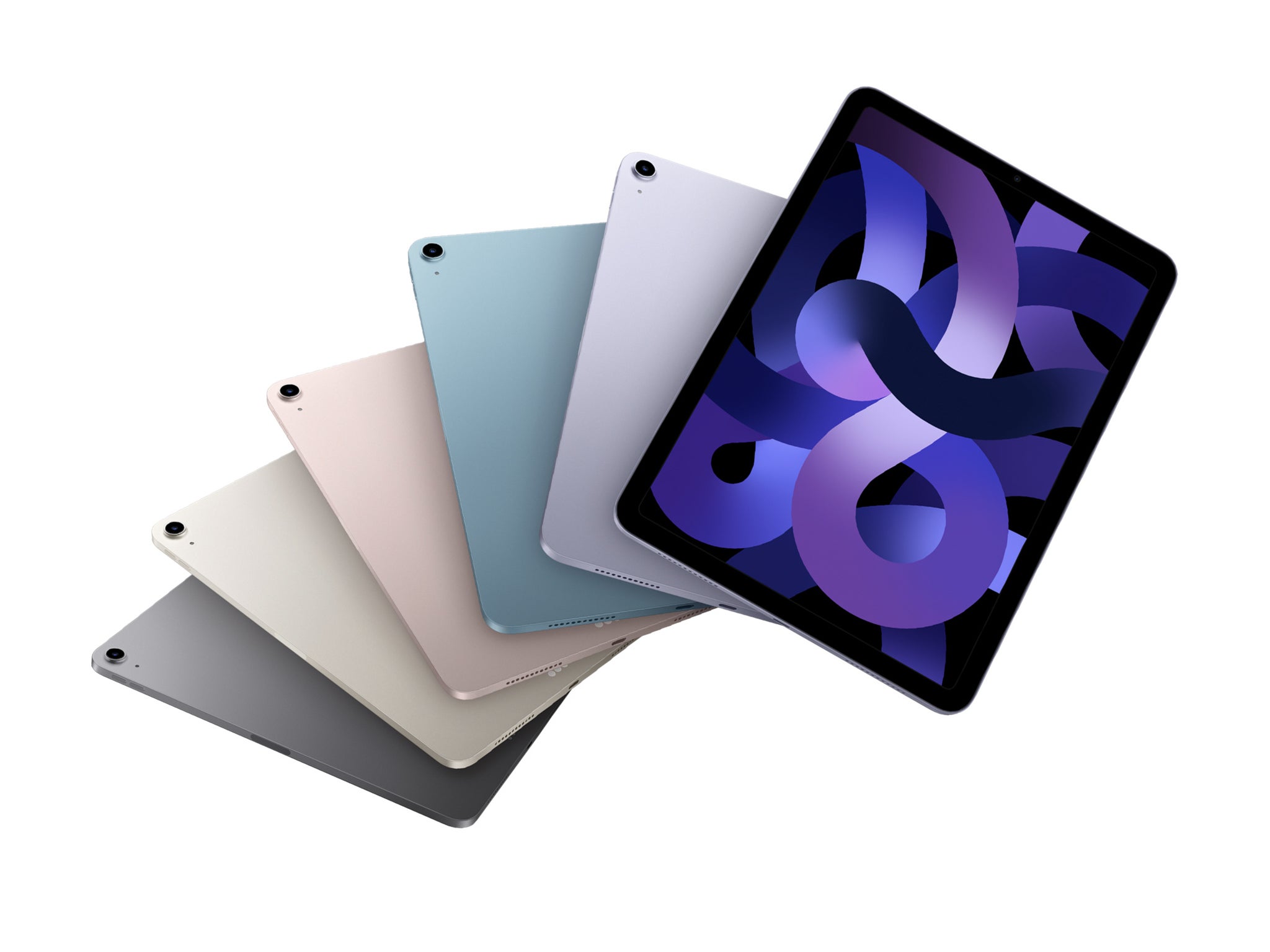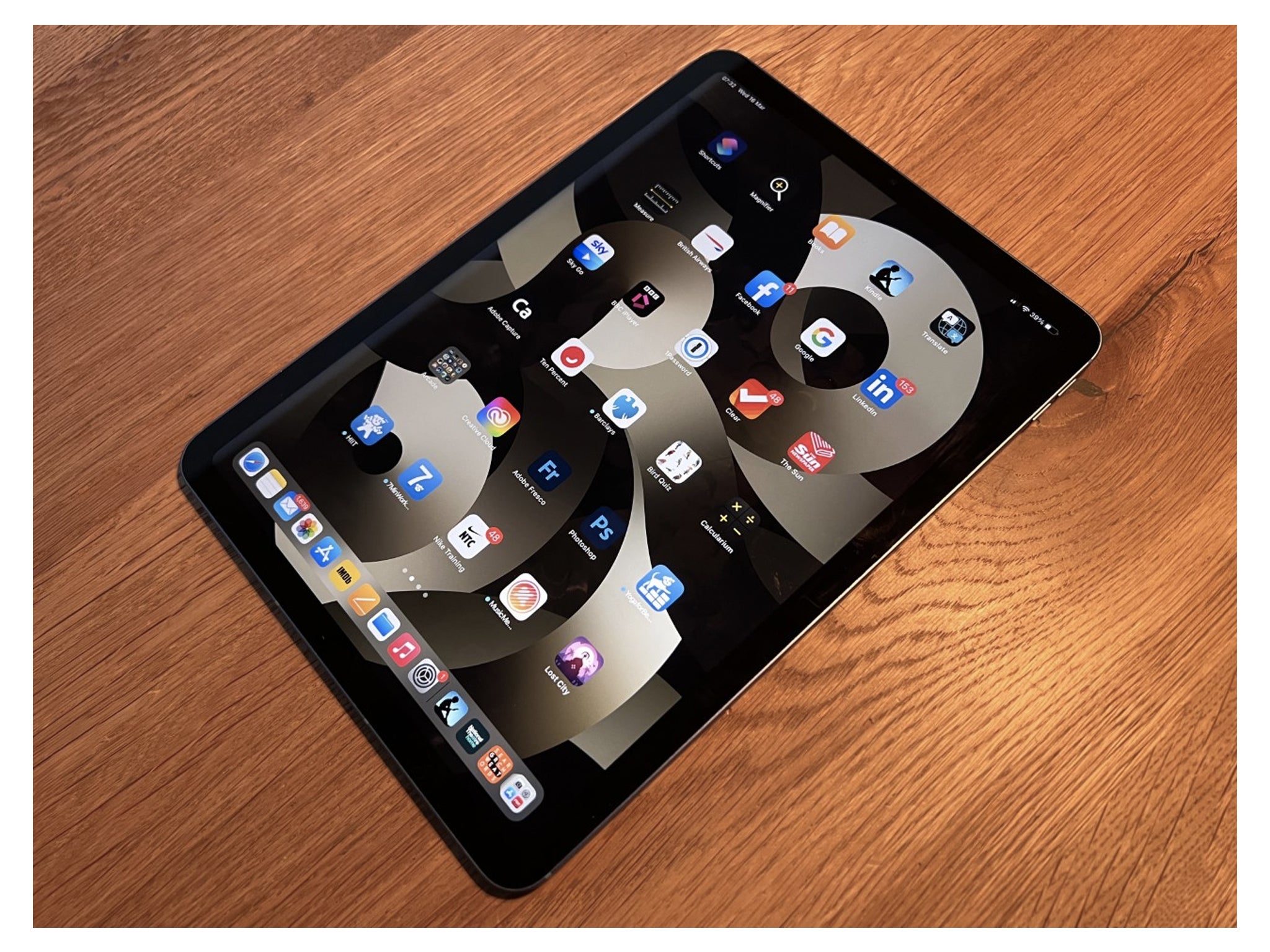The Independent's journalism is supported by our readers. When you purchase through links on our site, we may earn commission. Why trust us?
Apple iPad air 5 review: New M1 chip, 5G and brilliant video capability make it a spectacular tablet
To the eagle-eyed, it may look identical to its predecessor, but it’s packed with serious improvements

Apple’s iPad range now consists of four separate strands. There’s the iPad (£319, Apple.com), the entry-level, great-value model, for a start. The iPad mini (£479, Apple.com) is the smallest model, unsurprisingly, and has just been redesigned and supplied with a super-fast chip. The top of the range is the iPad pro (£749, Apple.com) which comes in two screen sizes, has multiple cameras and the Apple M1 chip which is powerful enough to run Apple’s iMac and MacBook air, for instance.
Finally, there’s the iPad air which, with this new model, reaches its fifth generation (£569, Apple.com).
The air first arrived as a super-light, super-thin alternative to the entry-level iPad, which it resembled. Then, in September 2020, it was suddenly redesigned to match the pro, with flat edges and an all-screen front.
This time around, that handsome design is unchanged, but the processor and other internals have been overhauled.
How we tested
I’ve been testing the new iPad air for a week, judging performance, battery life, ease of use and so on. Just as importantly, I’ve compared this device to the others in the iPad range to give an idea of which is the one to buy.
Read more:
You can currently pre-order the latest iPad air 5th gen until Friday 18 March, when it officially launches.
Apple iPad air, 5th generation: From £569, Apple.com

Rating: 9/10
- Display: 10.9-inch liquid retina IPS LCD, 264ppi
- Processor: Apple M
- Storage: 64GB, 256GB
- Rear camera: 12MP
- Front camera: 12MP
- Memory card slot: No
- Dimensions: 247.6mm x 178.5mm x 6.1 mm
- Weight: 461g
Design
If you have seen the last iPad air (£499, Currys.com) – the late 2020 model – you’ll know what this one looks like. They look identical, at least, apart from the colours. There are five this time: “space grey”, “starlight”, pink, purple, and blue. “Space grey” is a dark grey, “starlight” is silver with a twinkle of gold, and the other three are self-explanatory. The blue one is the brand-new shade that’s nudging a little towards teal.
Beyond that, the new iPad air has the same chic design as the old one. Highlights include a matte anodised aluminium finish with gently contrasted antenna bands around the edges. The Apple logo is the only shiny part of the case – silvery but colour-matched to the rest of the back. The only other markings on the rear are the single camera and three golden dots near the bottom, which are the connection points for accessories like the smart keyboard folio (an effective keyboard cover) and the magic keyboard, a pricey but absolutely brilliant cover, stand and backlit keyboard with trackpad in one.
The flat edges are similar to the design of the Apple iPhone 13 series (£719, Amazon.co.uk). One of the benefits of these is that the second-generation Apple Pencil (£119, Apple.com) – a smart stylus – can snap magnetically to the air to charge.
There’s one other key element to the design of the iPad air: the power button. When Apple switched to the new design, it removed the Touch ID fingerprint sensor home button from the front and enlarged the screen to 10.9in, squeezing the LCD right out to the edge. This is an all-screen machine. But where the pricier iPad pro has facial recognition to unlock it, there’s no Face ID on the air.
Read more: Best iPad deals – cheapest prices on Apple tablets
Instead, it built the fingerprint sensor into the power button which sits on the top edge. It is brilliant, working better than other fingerprint unlock systems I’ve tried. That’s because instead of touching the button to activate it and then touching again to unlock, the Apple Touch ID on iPad air unlocks with the first touch and if you let your finger rest, it opens the iPad to go to the app last open.
The iPad air has a single rear camera. It’s different from the one on the previous iPad air but remains at a 12MP resolution. It works well, though the iPhone, or a standalone camera, remain preferable photographic choices.
Under the bonnet
The new iPad air keeps its changes inside. The biggest one of these is the introduction of the M1 processor. This is a tremendously powerful chip that is at the heart of the latest iMac (£1,099.97, Amazon.co.uk) and the MacBook air (£999, Apple.com). It appeared in the iPad pro last spring. So, to put it in the substantially cheaper iPad air is impressive and suddenly brings the performance of the air up to pro levels – which is very fast and powerful indeed. Last spring’s iPad pro set new benchmarks for performance.
Read more: Apple iPhone 13 and iPhone 13 mini review
A processor this fast and capable makes apps work quickly and perform at pace for longer. It’s like the processor adds stamina as well as speed. On its own, the addition of the M1 processor, replacing the already-fast A14 Bionic chip of the last model, is enough to make a big difference to the value and performance of the iPad air.
The iPad pro 11in does have more to offer, of course, but it and the iPad air are now more aligned than ever before thanks to the M1. The pro’s screen size is only fractionally bigger (11in instead of 10.9in) and both use the same LCD technology. The larger iPad pro model – the 12.9in version – has a definite advantage in its screen technology, using mini LED backlights to add punch. But that’s a bigger, pricier option.

There’s another hardware upgrade in this iPad air: the front-facing camera. This has now been improved to a 12MP model which, combined with the M1 processing power means that Centre Stage is now present.
This is the brilliant video-conferencing capability that means the iPad’s smarts can keep you right at the centre of the action. The machine learning in the processor zooms in and out of the available image to keep you dead centre, even zooming out automatically when somebody else enters the frame. It’s on every other iPad so it was a shoo-in here, but it’s a welcome addition nonetheless.
And then there’s 5G. Available on the iPad pro since last spring and the iPad mini since late last year, the super-fast cellular connectivity is now available on the iPad air on the models with a sim card slot and cellular connectivity.
So, why would you choose the 11in iPad pro?
It’s a good question. With the pricing of the iPad air starting at £569 (Amazon.co.uk), against the £749 sticker price of the 11in iPad pro (Currys.co.uk), the air looks like the perfect balance – the Goldilocks choice.
After all, the M1 processor common to both is plenty fast and powerful enough for all users. The display has the same resolution in terms of pixel density (264 per inch). There are extra capabilities in the pro display with a dynamic refresh rate, for instance, but the air display looks fantastic. If you want a display that goes that bit brighter (600 nits) then the pro is your iPad, but the air’s 500 nits is still bright. The pro has a faster USB-C connector, though the one on the air has been upgraded, just not quite as much.
Read more: Mac studio – everything we know about Apple’s powerful new desktop computer
As mentioned above, the comparison is nowhere near as easy when you match it to the 12.9in iPad pro with its dazzling display, of course.
There are two rear cameras on both sizes of the iPad pro, plus a LiDAR scanner which improves photography and augmented-reality features, as against the single camera of the iPad air. But a large, flat slab of aluminium and glass has never been the ideal camera, compared to a hand-friendly iPhone or an ergonomically superior DSLR.
The iPad pro has Face ID, but Touch ID is so magnificently implemented here, that may not be such a distinct pro advantage. Sure, you can get the pro in bigger capacities, up to 2TB of storage, but the top storage capacity of 256GB on the air is pretty big. Both come in wifi and wifi plus 5G variants and while both have the same height and width, the pro is fractionally thinner.
In other words, in lots of ways the 11in iPad pro is better than the iPad air, but the new air is so improved that for most people the difference may not be worth having.
The verdict: Apple iPad air, 5th generation
Sticking with the previous iPad air’s design means it no longer has the wow of the new, but it continues to look great. But inside, there’s the super-fast and powerful M1 processor, taking the performance of this iPad closer to that of the latest iPad pro.
In its own right, this is a spectacular iPad, with a gorgeous 10.9in display, useful new features like Centre Stage for better video calls and speedy performance.
The iPad air’s beautiful look includes cute new colours. It offers the same versatility and intimate feel of previous iPads, has the convenience of compatibility with the second-generation Apple Pencil and the excellent magic keyboard, and boasts super-fast, responsive performance. For many people, this new iPad air will be more than powerful enough to make it the ideal choice.
Voucher codes
For the latest tablet discounts and other tech offers, try the links below:
Get the lowdown on Apple’s latest phone launch with our review of the new SE handset
